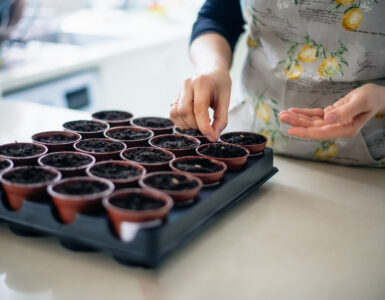Does it make a difference? What kind of a difference? How can you tell the difference? Does authenticity beat out imitation?? Does the imitation really taste as good or work as well in a recipe? When is it worth it? What are the considerations when asking whether it is worth it?
USU Extension’s Teresa Hunsaker talks about her preferences when it comes between real vs. imitation.
What are the considerations when asking whether it’s worth it about real vs. imitation:
1. Economics/Cost
2. Flavor/Taste
3. Nutrition
4. Convenience
5. Baking or Food Quality
Compare a few options available in the supermarket.
Lemons(for lemon juice) versus Real Lemon Concentrate
3 lemons at $.79 each=$2.37(might get almost ¾ cup—12 oz—of juice)/$2.39 for 16 oz
Personal Preference: For economics, the bottled lemon juice is less expensive ounce per ounce(except when lemons are in season), however it is tough to beat the fresh lemon taste!! Nutritionally they are about the same. And even though fresh lemons are a little inconvenient to juice, Teresa prefers fresh lemon juice most of the time. To maximize each lemon for juicing microwave for 15 seconds, roll with palm of hand on the counter, cut, and juice.
$1.99 16 oz/$1.49 16 oz
Personal Preference: If you watch for “real” sour cream to be on sale the economics do not become a factor. IMO may not taste as good to you, but if you’re trying to watch fat grams—every little adjustment can add up to considerable calorie and fat gram savings—then IMO or reduced fat sour cream would be the preference. Choose sour cream for a baked potato, but IMO for cooking and baking—such as in dips, stroganoff, and sour cream bundt cake, or sour cream chicken enchiladas. Adding chives and a bit of Mrs. Dash Herb Blend to IMO maximizes IMO on a baked potato. For overall baking quality, they are about the same for most things.
Pure Vanilla Extract versus Imitation Vanilla Extract
$3.99 for 1 oz/$3.49 for 2 oz
Personal Preference: Economics come into play here. Teresa uses a lot of vanilla in a given year. So unless she can find a good bargain on pure vanilla, she chooses imitation. She can tell a bit of a difference in some foods made with pure vanilla—fuller more rich vanilla flavor(example: homemade vanilla ice cream)—but will typically choose the imitation because it does not change the property or quality of baking to use the imitation—and in most things vanilla is not the primary flavor anyway and your family probably won’t know the difference. For entertaining and higher quality baking, Teresa uses the pure vanilla. Neither nutrition nor convenience are the issue here—it is all about the cost weighed against the flavor. Teresa likes the pure vanilla—so always look for the savings. Not much changes here in the way of overall baking quality of a product turning out or not.
Cream Cheese versus Neufchatel(low fat cream cheese)
$1.59 for 8 oz/$1.59 for 8 oz
Personal Preference: When ounce for ounce the price is the same, Teresa almost always chooses the lower fat version!! Very rarely in her baking does it make a difference in quality for her to use the lower fat option. Even Teresa’s New York Cheesecake is made with reduced fat cream cheese!! Cheese balls, spreads, Alfredo sauce, and many other great foods are typically prepared with the lower fat version. There are even some things she makes using the no fat cream cheese.
Crab versus Imitation Crab(Surimi)
$14.99 a pound canned/$1.99 a pound frozen
Personal Preference: Teresa does not choose crab very often, but when she does, she wants the real thing!! It is expensive, so she’ll watch for it on sale. There is no comparison. The imitation crab is good, and for a few a simple things like macaroni salad or crab salad croissant sandwich, she might choose the imitation, but for those nice occasions, it is the “real thing”. Just a note about surimi: Surimi is a type of processed seafood made up of less expensive varieties of fish such as pollock that are deboned, rinsed and minced until it is flavorless and colorless. The surimi is then extruded in filaments that are woven together to resemble the texture and appearance of crab meat muscle fibers. Then flavoring and colorants are added back in. In addition to crab, surimi is used to form imitations of expensive fish such as lobster, scallops or shrimp.
Comparing the products nutritionally, a 3.5-ounce serving of surimi contains 10 grams of carbohydrates, there is less than a gram in the same serving size of real crab meat. The serving of surimi has about 12 grams of protein, compared with 22 grams in real crab.
Imitation crab(surimi) is higher in sodium and lower in potassium than real crab meat. Surimi contains 841 milligrams of sodium and 90 milligrams of potassium, versus crab meat with 378 milligrams of sodium and 408 milligrams of potassium. One last note on nutrition: Surimi is not loaded with preservatives, and the flavoring is usually natural.
Bacon versus Imitation Bacon Bits(Bacos)
$3.99 for an 8 oz bag/$1.99 for 4.1 oz bottle
Personal Preference: Economics are in favor of the imitation, but not worth it in flavor for Teresa. She chooses bacon. Nutritionally 1 TBS of the real bacon bits (from the bottle or bag) is 35 calories and 2 grams of fat. The imitation bacon bits, for 1 ½ TBS is 30 calories and 1.5 grams of fat. In both versions she can also find “lite” or reduced fat. Convenience is equal—she no longer has to sit and brown bacon for many of her recipes. A few sprinkles of bacon bits in an omelet, in potato soup, in a frittata or breakfast casserole, and you’re good to go. Now, for a good old fashioned BLT—yes, you will have to fry the bacon.
Canned Whipping Cream versus Canned Cool Whip (both comparisons were done with the “lite” option)
$1.69/$2.89
Personal Preference: Economically the whipping cream takes it. Even in the less convenient option of having to whip cream, Teresa would still choose the authentic whipping cream most of the time—for cost and flavor. There are actually some dishes or desserts that the frozen imitation whipped cream(i.e. Cool Whip) actually holds up better, but for many things, it’s still cream. Here is a look at the nutrition of both of these two:
Calories: 20/2 TBS versus 20/2 TBS
Fat grams: 1.5 grams versus 1.5 grams
Cholesterol: 5 mg versus 0 mg
As a consumer, you can find the “lite” or non-fat version of cream and half and half. It makes it nice for watching calories and fat. However, economically those are at least double that of the original fresh cream versions. The debate is still out as to the “healthiness” of some of these preservatives and additives in some of our imitation foods.
Butter versus Margarine(tub)
$2.79 per pound/$2.99 per pound
Personal Preference: Most of the time the cost of 1 pound of butter is at least double that of margarine. So for shear economics most of us choose margarine. If we are trying to cut down on fat in our diet both are about the same—up until we move into the healthier versions of each. A person could spend an hour, easily, just trying to compare a better nutritional choice for the butter verses margarine debate. Teresa leaves the debate to you — there are volumes of reading available on that. She chooses margarine, for the economics, for everyday cooking and spreading, but always choose butter for the nicer occasions and fresh hot rolls/bread!!! Teresa also bakes enough to know that there is a distinct difference in how some foods turnout made with margarine instead of butter. Don’t scrimp in those recipes—candy making and fine pastries are two areas that for time and money, she uses butter. One last note—most need to cut down on our overall fat consumption—no debate there, so while she uses both butter and margarine, she uses them sparingly.
(*Prices will vary from season to season and store to store and brand to brand.)
For more information, go to the USU Extension website at www.extension.usu.edu or call (801) 399-8203















Add comment